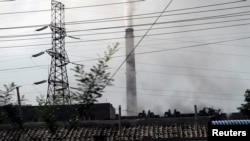North Korean leader Kim Jong Un sees coal as a key way to boost the economy, but burning more coal may worsen pollution in a country already choking on some of the world's most toxic air.
With the country staggering under the weight of international sanctions over its nuclear weapons program and human rights violations, defectors and analysts say Pyongyang has increased the domestic use of coal, which is blocked for export.
Seven coal power plants and one oil-fired plant produce nearly 50 percent of North Korea's electricity, with the rest coming from hydro power, according to South Korean government data. For households, coal is also a key fuel source for cooking and heating.
But an increased reliance, which Kim announced in his New Year address, may have deadly implications.
Per capita, North Korea's air pollution mortality rate was the world's highest at 238.4 deaths per 100,000 population as of 2012, a 2017 report from the World Health Organization (WHO) showed. That was 10 times higher than the rate in South Korea and higher than those of China and India, where smog often envelops major cities.
North Korea has acknowledged the correlation between coal and polluted air, but said it has had limited access to cleaner options.
"A combination of limited capital investment in infrastructure, limited access to efficient and low emission technologies ... and reliance on energy produced from coal in low efficiency thermal power plants has impacted air quality in urban and industrial areas," North Korea's 2012 report on environment and climate change outlook submitted to United Nations Environment Program (UNEP) said.
According to the report, coal is the main fuel used by homes in North Korean cities. In rural areas, wood is the main source, while coal comes in second.
Many rural North Koreans say they're aware of the pollution, but have more pressing problems.
"From the moment we woke up, we had to think about how much rice was left in our jar and how much firewood we had," said Ji Cheol-ho, a North Korean defector who lived in a coal mine town in North Hamgyong province before fleeing to the South in 2007.
"We don't die right away from eating dust, but we do if we don't eat food," said Ji, now an official at NAUH, a human rights activist group, who regularly talks to sources inside the North.
Hard to monitor
Analysts say North Korea has typically reserved its higher-quality coal for export. Using it domestically instead would have at least a small impact on minimizing additional pollution, experts say.
"Using good quality of coal would reduce emissions," said Kim Yong-pyo, professor of chemical engineering & material science at Ewha Womans University in Seoul.
But North Korean facilities lack sufficient filtering, so using more coal of any kind would likely lead to more carbon dioxide, sulfur dioxide and nitrogen oxide emissions, he said.
Reuters journalists in Pyongyang late last year observed thick smoke pouring from the stacks of several facilities, often covering parts of the capital in smog.
To raise public awareness about air pollution in 2017, North Korea's state television aired a special warning about it and provided tips such as wearing masks.
In 2003, North Korea set goals to address air pollution, and is working to upgrade older thermal power plants, according to reports the country submitted to UNEP and the United Nations Framework Convention on Climate Change.
But "limited technical and financial resources" prevented detailed monitoring of air quality, the report said, and it is not clear whether the North Korean government followed through on its recommendations.
Regional concern
Experts say a lack of reliable data make it difficult to gauge exactly how much damage Kim Jong Un's coal plan might do to the environment and air quality. But they agree it will have an impact outside his country's borders, especially in South Korea, Kim Yong-pyo said.
Air pollution harms and kills millions of people every year, especially in Asia, according to the WHO.
In South Korea, up to 20 percent of air pollutants are estimated to originate in the North, experts say.
In a 2017 survey by the state-funded Korea Institute for Health and Social Affairs, South Korean respondents said air pollution was their biggest concern, eclipsing even North Korea's nuclear threats.
Kim and South Korean President Moon Jae-in promised last year to restore the North's damaged forests in an effort to fight air pollution.
"Some air pollutants travel over to the South from the North. If forests are built well ... those could be reduced," South Korea's Forest Service minister Kim Jae-hyun, who visited Pyongyang last year to discuss the matter, told reporters in January.
Kim Soon-tae, a professor of environment and safety engineering at Ajou University, who has studied the impact of North Korean pollutants, said better data from the North is essential to devising air pollution policies in the South.
"North Korea's air quality is our homework to do, and we have to think about North Korean people's health as well," Kim said.







